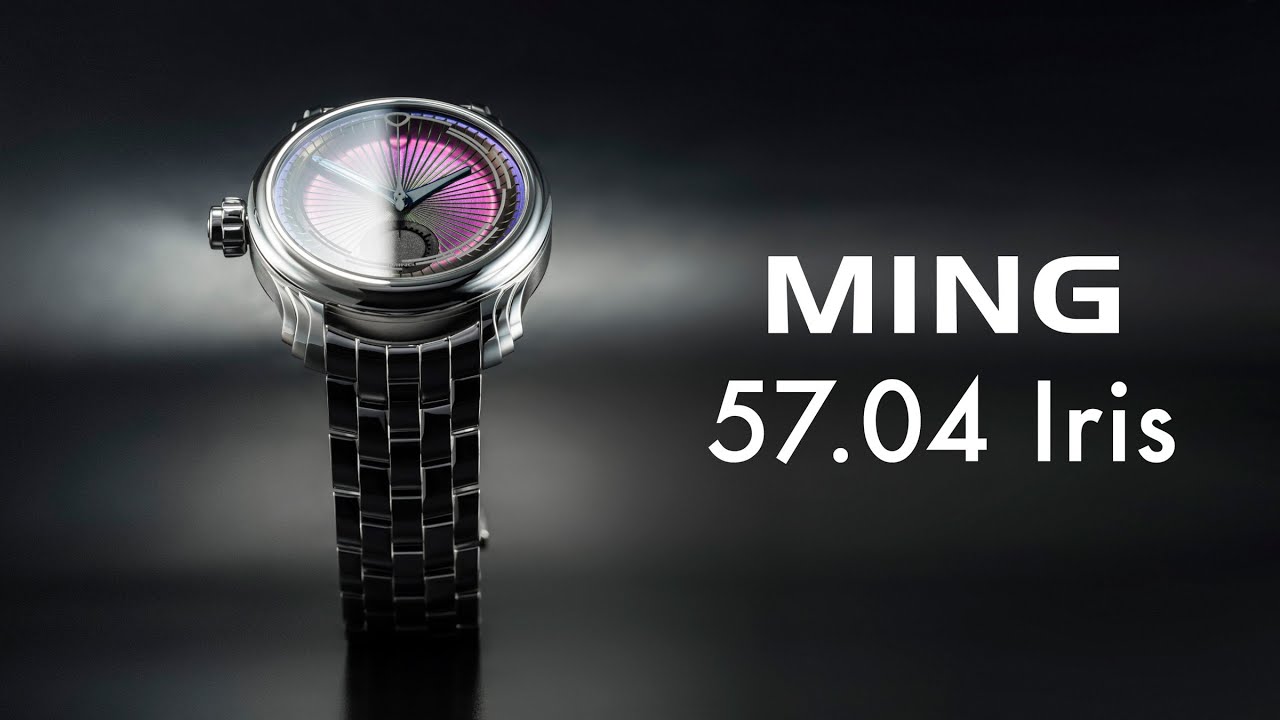The new MING 57.04 Iris is not only a release timed to celebrate the brand’s eighth anniversary, but also a pivotal moment in its history. It represents the opening chapter of the fifth-generation design language, a marked stylistic evolution that draws inspiration from modern Art Deco while embracing the brand’s characteristic love of light play and geometry. At the same time, it ushers in technical novelties: the first destro (left-hand operated) watch from MING and one of the most elaborate case constructions the brand has attempted. Limited to only one hundred pieces, the 57.04 Iris is both an anniversary piece and a statement of intent, showing what MING envisions for its next chapter.
Shifting colours, sculptural presence
The first impression when encountering the Iris is defined by the dial. Its deeply dished, concave form draws the eye towards the centre. This sculptural base is enhanced by a multiphasic colour treatment over brass which creates an elusive spectrum of shades that shift between turquoise, violet and blue. It is not a static dial; it is alive, mutable under changing light. MING calls this optical effect “Iris,” both for its resemblance to the human eye’s radial striations and the chromatic intensity of the flower.

Floating indices, laser-cut into the sapphire crystal and filled with the brand’s own Polar White luminous material, hover above this shifting canvas. They lend the composition a sense of depth, detaching time indications from the underlying surface. The hands keep to MING’s signature language—diamond-cut, blue coated and filled with Super-LumiNova X1—offering crisp legibility against an ever-changing backdrop. A chronograph minute register at six o’clock adopts a sandwich construction filled with luminous material, but departs from the traditional circular sub-dial form in favour of a more sculptural disc, subtly reinforcing the sense that this is a watch which refuses to follow familiar codes.

Sellita for MING SW562.M1
If the dial offers spectacle, the movement brings pragmatism infused with character. At its base lies an exclusive development with Sellita, the SW562.M1, tailored specifically for this monopusher chronograph configuration. The architecture is hand-wound, offering approximately 60 hours of autonomy from a full wind, and it presents central chronograph seconds with a 30-minute counter at six o’clock.

Far from being an off-the-shelf calibre, this movement comes dressed in finishes that align with MING’s affinity for sculptural contrasts. The mainplate is anthracite, industrial in tone yet refined, while atop it sits a three-quarter plate richly coated in 4N gold tone. The juxtaposition of dark surfaces against warm, almost architectural metallic planes is striking when viewed through the sapphire caseback. Functional robustness meets considered artistic decisions: it is an accessible chronograph calibre made distinctive and tailored for both aesthetics and ergonomic utility, the destro configuration allowing the crown and single push-piece to be made larger and more tactile without interfering with wrist comfort.

Architecture in steel
The Iris emerges housed in a 40-millimetre stainless steel case whose proportions have been carefully judged. At 11.85 millimetres thick and 47.8 millimetres lug-to-lug, it balances presence with wearability across a wide range of wrists. This is no anonymous round case: its sculptural form is an essay in stepped lugs, each comprising multiple parts, nine in total per side, to achieve a nested, tiered profile that walks the line between Art Deco geometry and MING’s established minimalist DNA. Polished upper facets transition crisply into brushed flanks, giving the watch varying character under different viewing angles. The construction is assertive, unapologetic, and yet refined.

Sapphire crystals front and back, with anti-reflective coatings, protect the watch, while a practical 100 metres of water resistance makes the piece fit for daily use rather than relegated to the confines of a display cabinet. The chronograph pusher, flush with the case band and opposite a large tactile crown, reinforces the asymmetric identity of this destro configuration. The watch is delivered on the stainless steel Universal Bracelet as well as an anthracite goat strap fitted with a tuck buckle, underscoring MING’s principle of modular wearability.

Closing thoughts
The MING 57.04 Iris marks a moment of maturity for the brand. After eight years, it presents not only a celebratory chronograph, but also the fifth-generation design language that will define what comes next. The decision to skip a fourth generation, in deference to Asian superstition, gives this collection an additional layer of storytelling—the Iris, therefore, is not only new, but laden with the significance of a symbolic rebirth.

What resonates most is the integration of all elements: a dial that constantly changes, a case that redefines familiar proportions through layered construction, and a movement that balances reliability with individualised finishing and practical aesthetics. It is limited to one hundred pieces, priced at CHF 6,250, and continues to reflect MING’s philosophy: bringing refinement, light, and surprise to the enthusiast while retaining an experimental edge. The 57.04 Iris is not designed to fade quietly into the background; rather, it commands attention—a striking beginning to a new era in MING’s story.





















